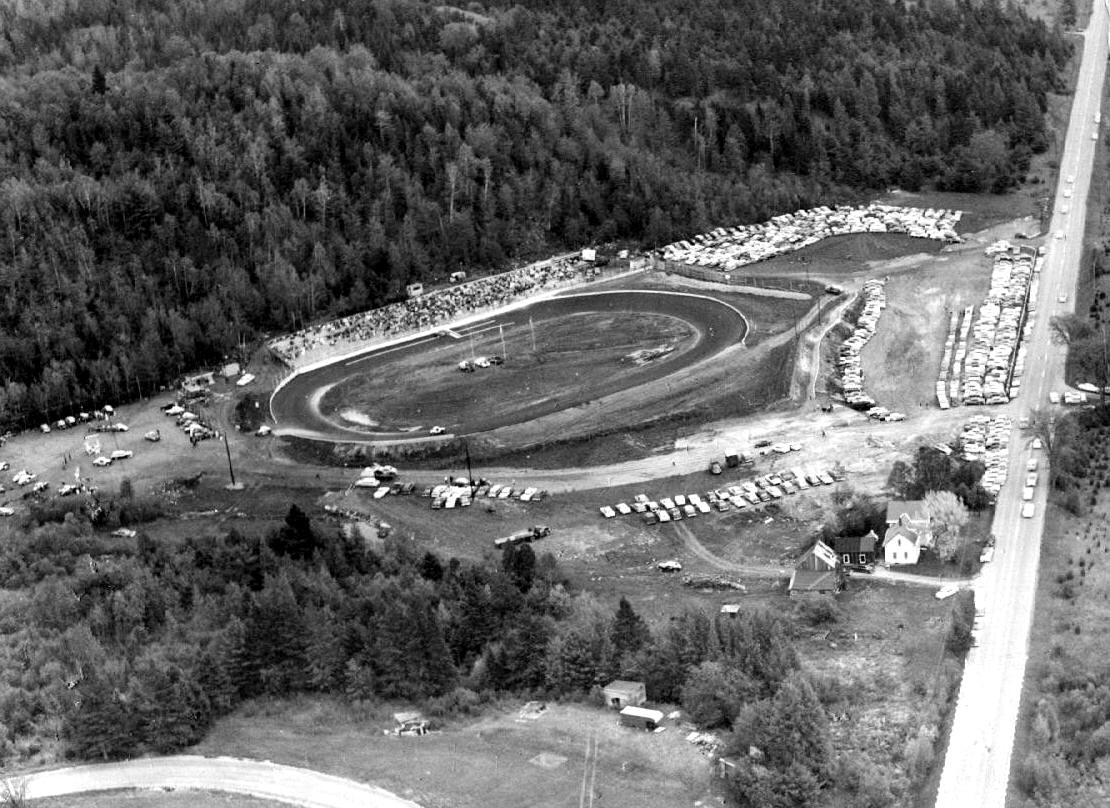
THE
BILL'S BACK IN TIME COLUMN PAGE
Copies of my column in Mark Thomas' "Racin'
Paper"
Site Column #41 from Column 55
BILL’S BACK IN TIME
By Bill Ladabouche
SOMEWHAT OF A RESURRECTION IN THE NORTHEAST
Back in the 1970’s, when my first wife and I would take small trips with the children, I happened to find myself on Route 18, heading from the St. Johnsbury, Vermont area to Littleton, New Hampshire. I was aware, from having done columns on forgotten speedways, that there was an old race track lying somewhere near Waterford. So, as we steered the Dodge Aspen wagon down 18, I began looking for signs of a derelict track.
Nearing Lower Waterford, I started getting that feeling that makes your hair stand up on the back of your neck. I had noticed a rusty metal fence in a field beside the road, and I thought this wasn’t anything belonging to an old farm or homestead – so we stopped. With my 6 year-old running ahead , we plowed on into the property [with no regard for possible shotgun – bearing owners] and came upon the vestiges of Northeastern Speedway.
The little old paved track was still in such good shape, back then, that someone had to put several piles of dirt in the middle of the front stretch to keep the local hunyaks from racing around it on moonlight nights. We saw the retaining wall, and noted the rotting remains of the bleachers, then being occupied by a grass snake warming itself in the warm July afternoon sun. There were small trees growing up everywhere, and I had no idea to look for the pits because I actually had no idea where they were.
The kids were at the age where they bored quickly and my wife didn’t have any interest in racing whatsoever, so I convinced everyone to let me shoot a few photos with the good ol’ Kodak Instamatic, and we left. At that time, I had no idea that I would, one day, make dredging up information on old race tracks my deeply involved hobby. I’m glad I took those shots when I did. When Justin St. Louis went to the site in 2008 and took a roll of shots, the site was profoundly overgrown and it was much harder to see the same sights that were very easy in 1978.

This aerial shot of
Northeastern, around 1962, shows a neat little race track that was well
maintained but not particularly elaborate. [ACT Archives Courtesy of Cho Lee]
Since Justin was there, some very interesting developments have sprung up in Lower Waterford, Vermont. A man named Paul Belfray has gotten possession of the land, and has expressed a strong desire to restore the facility. I have not talked with Belfray about his intentions if and when he gets everything back in order; but, it is certain that he intends to put it back to as close to its original look as he can manage. Thus far, Paul has managed to scrape decades of overgrowth off the asphalt racing surface, revealing a track that is still largely intact. He now intends to start clearing out trees.
I cannot imagine this track ever becoming active again because of Vermont’s unfriendliness towards anything that does not hug trees. I would rather think it would be easier to start a landfill that specialized in nuclear waste than to start up racing there again. But, I wish Paul all the luck in this most noble of endeavors and I hope we would all do what we could to help him.
Looking down to the front
stretch at Northeastern, around 1978. The good condition
of the track is still apparent. [Ladabouche Photo]
My attempt at historical background is from what I have heard and what I am inferring – it may not be perfect. Northeastern Speedway was up and running toward the end of the 1950’s, having been preceded by places like Webster Flats, Lyndonville; the Morrisville track, Lake Megantique in Quebec, and the tracks in Sheffield and Concord, Vermont. The track was a success, and eventually would run along with the Riverside track in Groveton, New Hampshire.
It was apparently a place of significance in that small Connecticut River valley town because there wasn’t much else going on up that far North in Vermont. When the track would open, local marching bands would perform. I once heard that the site was infrequently used for events other than racing. The track’s location was very near to the old Concord, Vermont track, only about three miles to the northeast, but Northeastern racing had advanced a great deal since the crude days at Concord.
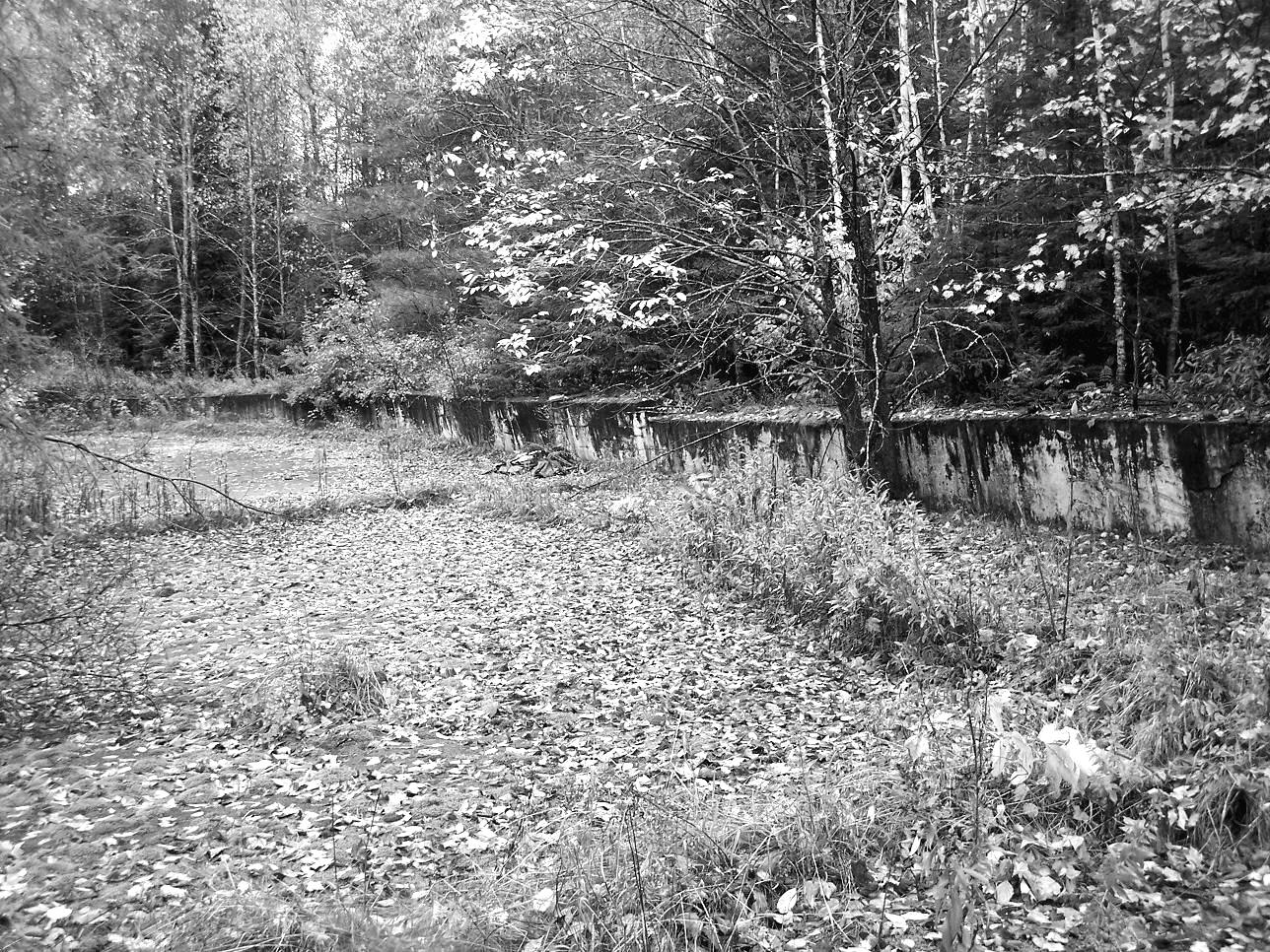
When Justin got there in 2008, his photos show evidence of how much more the site had grown in . [Justin St. Louis Photo]
At Northeastern there developed a prototype race car – the early thirties, three or five window flathead coupe, designed especially for a small paved track. This was not typical of that era, as most track in Vermont were dirt and the stocks cars of the far northern parts of Vermont were noted for being very large and heavy. This represented progress for northeastern racing, as tracks like Malletts Bay, in Colchester and Stateline in Bennington were fielding cars that were far superior to anything on the Canadian border.
A cadre of stars started to develop from the paved surface of Northeastern: New Hampshire drivers like Ronnie Marvin of Bethlehem, the Ingerson boys from Littleton, and Freddie Mills from nearby Groveton were a few of these. From Vermont came East St. Johnsbury’s Johnny Gammell, Dwayne Remick from St. J., Chester Wood from Orange, and Northfield’s Larry Granger. These were only a a few of the dozens of drivers who honed their skills in Waterford and then – when the little track closed – went to stardom at Ken Squier’s flashy new Thunder Road International Speedbowl in Barre, Vermont.
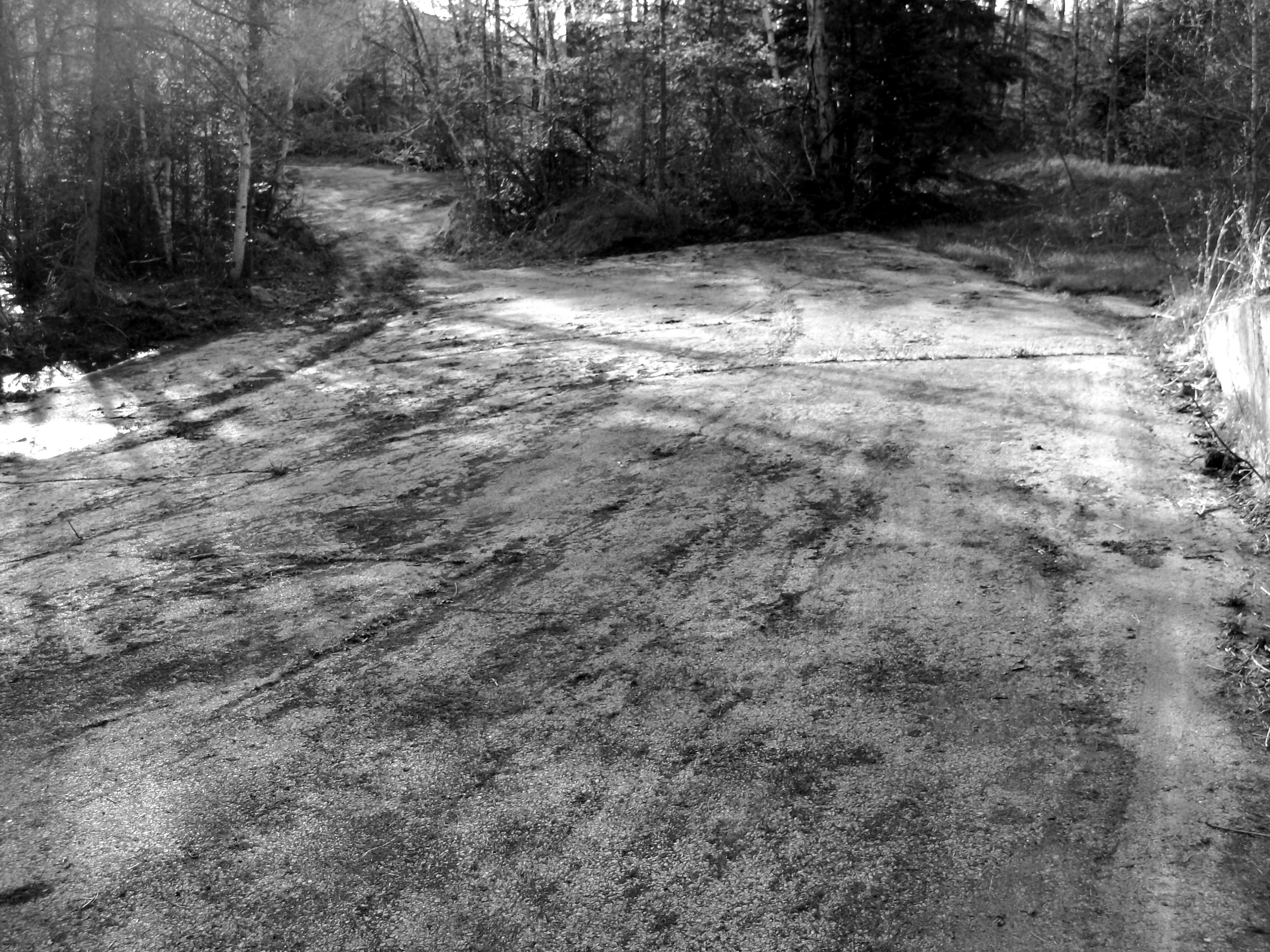
Belfray’s shot shows how he
is uncovering the track surface, One of the dirt piles put down in the
1970’s is still there.. [Paul Belefeuille Photo]
So many of the big names in the early history of T Road were veterans from Northeastern. Harold “Hard Luck” Hanford is one of the surviving stars. The racing community just lost Henry “The Frozen Logger” Montandon in the Spring of 2008. Although they raced all over the East in the 1950’s, the legendary George Barber racing team made Northeastern a sort of home track for a while, with driver Roy “Pappy” Forsythe. Ghostly names like Skip Easter, Dale Gilbert, Mike Osborne, Glen Gadapee, Bobby Hood, and Paul Martell float around the still, damp evening air on the grounds of Northeastern – waiting for the green flag to drop again. Let’s hope it does.
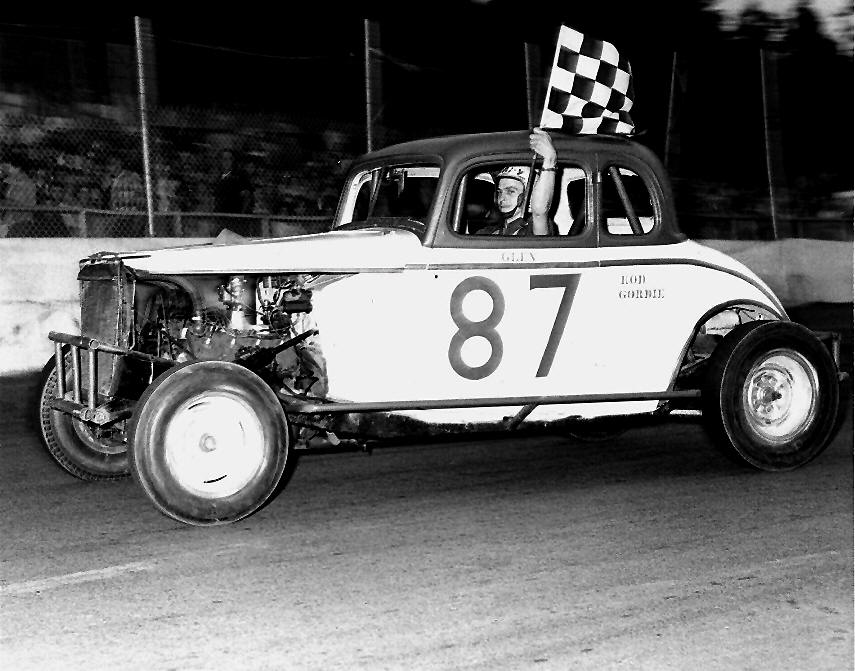
Glen Gadapee and his clean
five window coupe are typical of the Northeastern coupes in its
heyday. [ACT Archives Courtesy of Cho Lee]
Covering Northeastern brings to mind the #4 Studebaker that both Johnny Gammell and Bill White [present day Bear Ridge official] drove. The era we are discussing enjoyed a brief love with Studebaker products as local stock cars. That particular Studebaker was a wild-looking affair, with headers sticking out of the engine like a modified. It was wrecked by White at Thunder Road around 1962 when Stub Fadden unceremoniously dumped him into the front stretch wall.
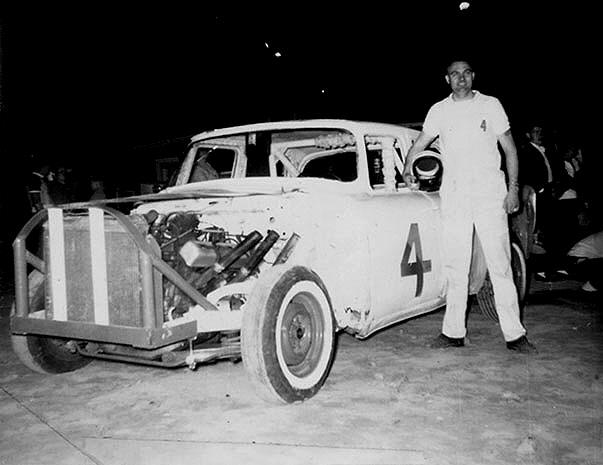
Johnny Gammell, a Vermont
state champion, once drove this odd – looking
Studebaker at Northeastern. The car was also driven by Bill White. This
was a B Class car and was towards the end of the track's life. [Photo Courtesy
of Ken Paulsen]
Another track that saw some significant Studebaker involvement was Airborne Park Speedway, across Vermont and across Lake Champlain from Northeastern. A much more established track, Airborne saw the Burl brothers, Norm and Don, build Studebaker Hawks that ran at Airborne and later at Thunder Road and Catamount. For quite some time, one of the Burls had young local star Wild Bill Branham in the white 7UP. It was one of the first noteworthy cars in the Flying Tiger division at Catamount Stadium when the track opened in 1965.
A yet – to – be – lettered
white 7UP Studebaker flies around Airborne with Norm Burl at the controls.
[Photo by Bob Mackey, Courtesy of John Rock and Bobby Castine]
Perhaps the most famous Studebaker of the era was not close the most successful. Pete Corey, of Crescent, New York, a known innovator, fielded a full – bodied Studebaker Hawk amid the fields of big – name sportsman coupes at Fonda Speedway around 1963. The Corey car, when in full slide in the turns, could just about block the racing surface. He had some success with the cars in the wetness and dampness of early spring racing. But, the car floundered when the clay Fonda surface started to be drier and harder. Corey, never known to be particularly patient, then cut the car up with a torch and field a 1937 Chevy coupe. Bit Corey’s mystique and notoriety made his Studebaker the best – known one of the 1960’s bunch.
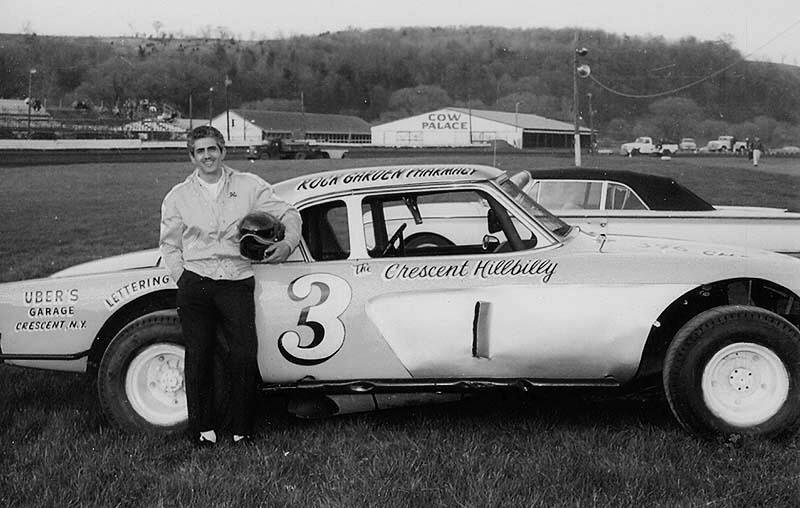
Pete looks very happy with
his snazzy Studebaker here, in the Spring. But, weeks
later, the car was in pieces behind his body shop in Crescent. [Arnie Ainsworth
Photo]
Return to the Columns Link Page
Return to the Main News Page